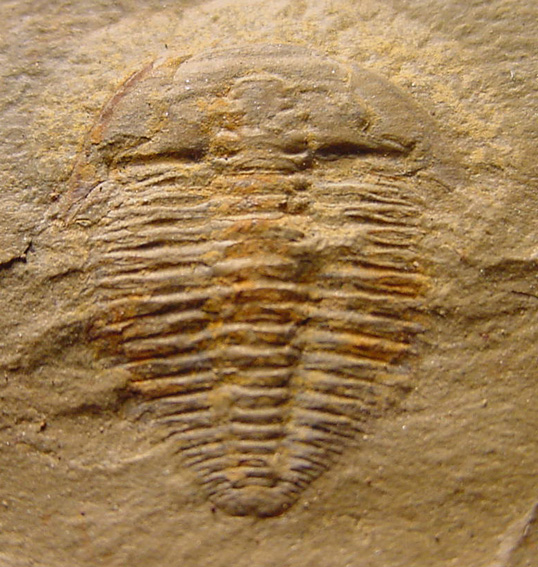


Eokochaspis piochensis (Palmer in Palmer and Halley, 1979)
Name: Eokochaspis piochensis (Palmer in Palmer and Halley,
1979)
Locality: Highland
Range, Lincoln Co., Nevada
Stratigraphy: left: Pioche Shale, just above the Lower Cambrian olenellid
extinction boundary; right: Comet Shale Mbr., Pioche Shale Fm., Middle Cambrian
Remarks: left: photographed by Andrew Milner; middle and right:
Photos: G. Ast.
The specimen in the middle has another tiny trilobite in the bottom right corner. This is most likely a Ptychoparella sp. indet.
Distinguishing
characteristics of Eokochaspis species in the "C-Shale":
Eokochaspis nodosa is the lowest species in the Comet Shale Member. Eokochaspis
nodosa differs from E. piochensis in having an unequal division of
the frontal area with a shorter preglabellar area, a slight median inbend of the
anterior border furrow, and wider (trans.), and less tapered, convex anterior
border; longer, more inflated glabella with deeper glabellar furrows; stronger
occipital node; recurved librigenal spine; a pygidium that has better defined
pleural bands and better developed median notch; and granular ornamentation.
Eokochaspis delamarensis occurs in the second ribbon limestone bed in the
Comet Shale Member, approximately 3 to 4 m above the boundary limestone. Eokochaspis
delamarensis differs from the other species of Eokochaspis in its
cranidium with less convex glabella, effaced furrows, weak ocular ridge, and a
weak occipital node; its librigena with a shorter librigenal spine that is
slightly deflected laterally; and its pygidium with a small median notch.
Eokochaspis piochensis occurs about 6 m above the boundary limestone in
the Comet Shale Member. The shale specimens of E. piochensis are
dissimilar to E. nodosa in having less prominent occipital node,
relatively shorter anterior margin, lack of a median inbend of anterior border,
shorter less inflated glabella, more curved and more tapered anterior border,
recurved librigenal spine, and less pronounced pygidial pleural bands. The shale
specimens of E. piochensis are dissimilar to E. delamarensis in
having less effaced axial and glabellar furrows, more pronounced ocular ridges,
more recurved posterior area of the fixigena, more prominent occipital node and
longer and non-deflected librigenal spines. The shale specimens of E.
piochensis are dissimilar to E. longspina in having more anteriorly
placed palpebral lobes, parallel to slightly convergent anterior branch of the
facial sutures, slightly convex anterior border, relatively shorter librigenal
spine and less transversely elongated pygidium.
Eokochaspis longspina occurs in the third ribbon limestone of the Comet
Shale Member, approximately 8 m above the boundary limestone. Eokochaspis
longspina differs from other species of Eokochaspis in its long genal
spines (about equal to the cephalon length), broad anterior margin, and flat
anterior border. This species is most similar to E. delamarensis but
differs in having the cranidium with more relief and better defined furrows, the
anterior branches of the facial sutures are slightly divergent, the librigenal
spines are longer and narrower, and the pygidium has a slightly more pronounced
notch.
(courtesy J. Cook)